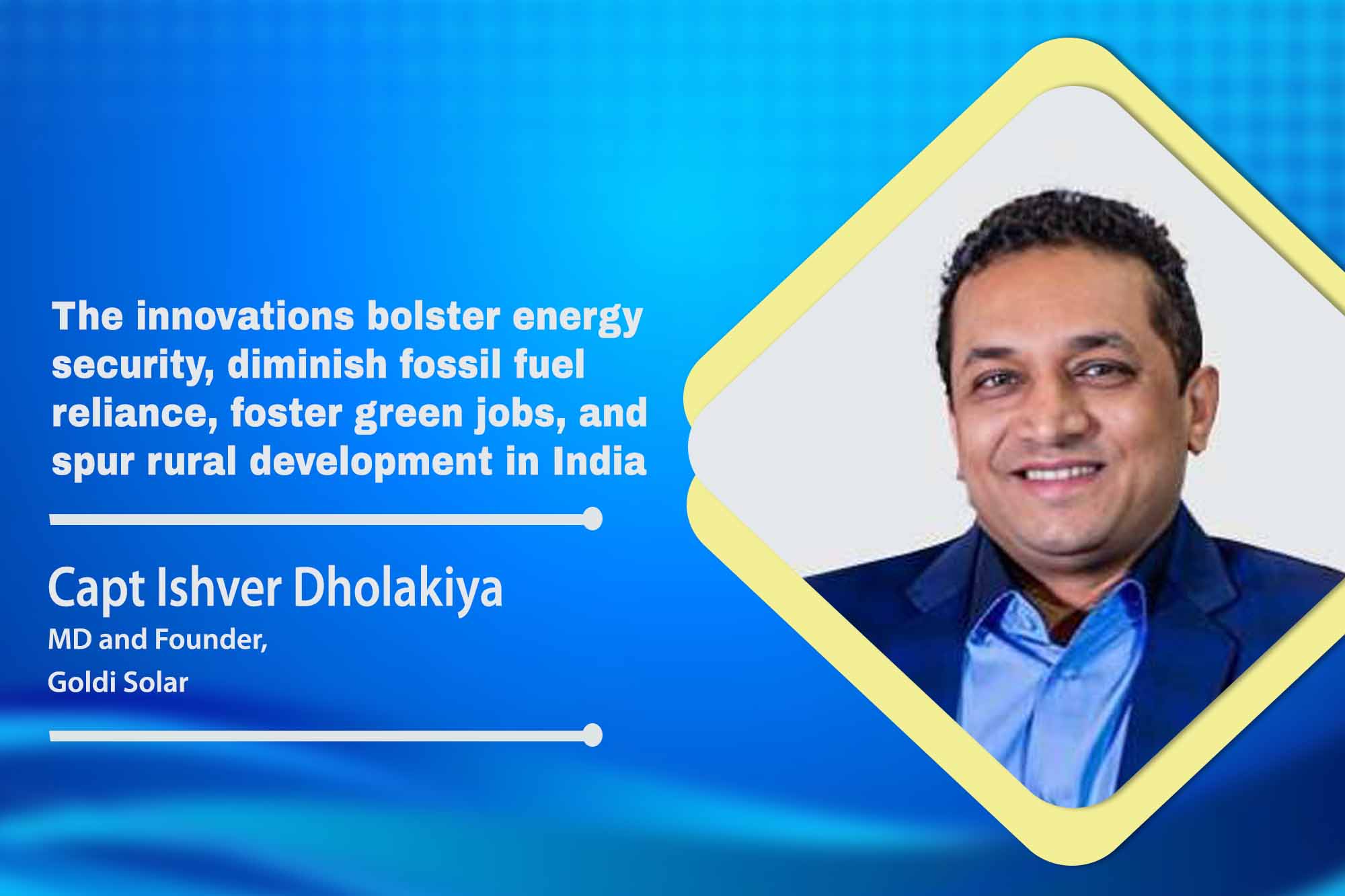Technology is driving RE integration and sustainability
By EPR Magazine Editorial March 27, 2024 12:05 pm IST
By EPR Magazine Editorial March 27, 2024 12:05 pm IST

The innovations bolster energy security, diminish fossil fuel reliance, foster green jobs, and spur rural development in India.
Advanced metering infrastructure provides real-time energy consumption and generation data, enabling efficient grid management and integration of renewable sources like solar power. These technological advancements collectively contribute to the feasibility and scalability of renewable energy integration into the electrical power segment, paving the way for a more sustainable and resilient energy future. Capt Ishver shares the latest industry trends in talks with the EPR Magazine.
How do recent tech advancements boost renewable energy integration and sustainability in India’s power sector?
Recent technological advancements, such as improved solar cells and wind turbine efficiency, advanced energy storage solutions like Lithium-ion batteries, and the implementation of smart grid technologies, have significantly enhanced the feasibility and scalability of integrating renewable energy into the electrical power segment. These innovations mitigate intermittency issues, improve grid efficiency, and enable better monitoring and management of renewable sources. In India, these advancements offer profound benefits, including enhanced energy security, reduced reliance on fossil fuels, improved air quality, creation of green jobs, and rural development. Falling costs make renewables more affordable, while advancements in energy storage and smart grids bolster grid stability. India’s commitment to these technologies positions it as a global leader in sustainable energy, fostering a more resilient and environmentally friendly energy future.
How do diverse solutions effectively address intermittency challenges in modern grids?
Diverse solutions are emerging to tackle intermittency in renewable energy. Energy Storage Systems (ESS), like battery storage and pumped hydroelectric storage, capture excess energy for later use. Hybrid renewable systems merge different renewables to stabilise output. Demand response and grid flexibility, facilitated by smart grids, manage fluctuations. Geographical diversification spreads projects to counter local weather patterns. Improved forecasting and predictive analytics enhance generation prediction. Integrating dispatchable sources like natural gas or hydro ensures continuous supply. These strategies synergise to create a more dependable and sustainable renewable energy grid, mitigating intermittency challenges effectively.
What key policies drive RE adoption in India, and how do they address enforcement disparities?
The drive towards renewable energy adoption is propelled by a suite of policies and incentives to foster investment in the sector. Renewable Purchase Obligations (RPOs) mandate electricity distributors procure a portion of their power from renewable sources, yet enforcement disparities persist among states. Feed-in Tariffs (FiTs) have jumpstarted renewable energy, particularly for wind and solar, though they are being supplanted by competitive bidding. Accelerated depreciation and tax incentives, including holidays and concessional duties, have lured investments, especially in the early stages. Renewable Energy Certificates (RECs) enable producers to recoup costs but grapple with oversupply and regulatory uncertainties. The National Wind-Solar Hybrid Policy promotes hybrid projects to mitigate intermittency, anticipating substantial investments. Viability Gap Funding (VGF) aids large-scale projects by bridging financial shortfalls. Despite progress, challenges endure, necessitating ongoing reforms and innovation to realise ambitious renewable energy goals and advance towards sustainability.What are the primary challenges microgrids and smart grids face in renewable integration efforts?
Microgrids offer invaluable benefits like islanding capability, flexibility, and reduced transmission losses. However, they face high initial costs, regulatory hurdles, and limited scalability. Conversely, smart grids provide real-time data, dynamic control, and demand-side management, aiding in renewable integration. Yet, they encounter cybersecurity threats, interoperability issues, and investment needs. Overcoming these challenges demands streamlined regulations, increased funding, and robust cybersecurity measures. Ultimately, microgrids and smart grids play crucial roles in the renewable integration landscape, necessitating concerted efforts to realise their full potential.
How can RE infrastructure minimise environmental footprint while advancing sustainability goals?
Minimising the environmental footprint of renewable energy infrastructure is vital for sustainability. Efforts include Life Cycle Assessments (LCAs) to guide improvement, sustainable materials and manufacturing processes, and responsible siting to minimise ecosystem impacts. Waste management and recycling, water conservation, and habitat restoration further reduce environmental harm. Supply chain sustainability and ongoing research foster eco-friendly practices and innovation. Combining these strategies ensures that renewable energy development progresses responsibly, mitigating environmental damage and advancing towards a more sustainable future.
Spokesperson: Capt Ishver Dholakiya, MD and Founder- Goldi Solar
We use cookies to personalize your experience. By continuing to visit this website you agree to our Terms & Conditions, Privacy Policy and Cookie Policy.